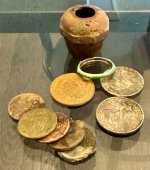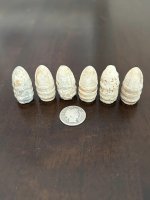Dave Rishar
Silver Member
Dave Rishar, what you're saying sounds much like our Ft. Ord barracks. Which, like yours got abandoned, and sat for years. Then eventually demolished, and is now vacant land. And like your scenario, I too could probably find myself a "no", if I kept asking various bureaucrats. I mean, put yourself in their shoes. What do you THINK is the easy answer. It sounds like you acknowledge that they are just giving this out as an arbitrary "no", when .... no such rule exists that specifically says such a thing. I mean, sure: they can "morph" something ELSE to apply to the "pressing question" to back up that no they just invented.
But at Ft. Ord, we helped ourselves routinely, and found silver and wheaties. We even had some MP's come up and question us more than once. But once we assured them we weren't INSIDE the boarded up buildings, they shrugged their shoulders and moved on. Now *some* people would take that as a green light, right? But all it means, is that I didn't ask high enough up the ladder of bureaucracy.
And now, all these years later, the old barracks were torn down, and the fed. govt. gave off the land of the former Ft. Ord base to the cities that surrounded the base (Seaside, Marina, Del Rey Oaks, etc...). And we hit the spots where they were, and get a bit more coins that had been under wooden porches and so forth. The lands were given to neighboring cities for eventual development. But the housing market crash of 2008-ish hit, and developements have yet to occur. There's no fences or signs surrounding the naked land sites of the old barracks now. I suppose *technically* some people would say that a person must go "get permission" from the city's who now have this land, right? But alas, the same thing would no doubt happen there. The request would get passed back and forth through various desks, and ..... guess what ?
Indeed. I'm unfamiliar with Ft. Ord and can't comment on it, but I can comment on my own situation. A few things:
1. We have security clearances, which means that we can be thrown out fairly easily. It happens all the time. I have to watch what I do outside of work. (I also have to watch what I do inside of work, but that's another story.)
2. It was a fairly small base, around 400-500 acres. It was a small arms range. If I go and ask someone in charge, it will be a small arms range without much acreage. They won't care where the impact areas were. They likely don't know anyway. They will just say no, and this is my job.
3. This isn't an open base. It was fenced off in my day. It's fenced off today. If they wanted me in there, there would be a turnstile with a badge reader.
4. The camp wasn't completely abandoned. The upper camp is still in use and is now fenced off, which it wasn't in my day. They tore most of it down but left one building standing. I know what they're using it for but I don't know the periodocity, nor do I care outside of my own activities. But it's military, and it's post-9/11, so eff you and me, regardless of our veteran status.
I could push it, yes...and I'd like to think that I could talk my way through the process if someone showed up asking questions. The possibility remains that I might not, and whatever I might find there (based on what I found downrange) is not worth my job. So that's it. I'll keep asking. When someone important says yes, I'll go out there and dig up some artifacts. Until then, I'll dig something else. I was given the impression that this was a federal thing, but I received no hard data. I'
ll keep pushing.
To the OP: Your choice. Choose wisely.







